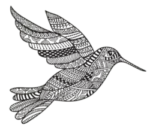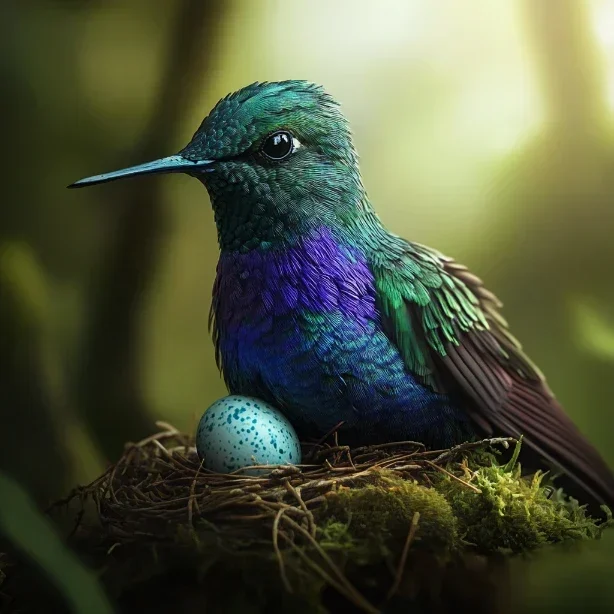(Or: How Nature’s Tiniest Birds Ensure Their Next Generation)
In the complex world of avian reproduction, hummingbirds have developed some of the most fascinating and unique breeding strategies in the bird kingdom. These tiny architects of the future combine elaborate courtship displays, precise nest construction, and remarkable parenting skills to ensure their species’ survival.
Let’s begin with some breeding facts that make ornithologists take special notice:
- Elaborate aerial courtship displays
- Smallest eggs of any bird relative to body size
- Single-parent nesting strategy
- Multiple broods per season
- Precise temperature regulation during incubation
The Courtship Ballet
The story of hummingbird reproduction begins with one of nature’s most spectacular shows. The male of the pair transforms the sky into their personal stage, performing aerial displays that combine speed, precision, and theatrics in ways that would make any choreographer envious.
Courtship displays include:
- U-shaped power dives
- Synchronized color flashing
- Height-climbing demonstrations
- Figure-eight patterns
- Sound effects from specialized feathers
The Dating Game
Once the aerial show concludes, hummingbird courtship enters a more intimate phase. Unlike many bird species, hummingbirds keep their relationships strictly professional – it’s all about efficiency and effectiveness.
The mating process involves:
- Territory establishment
- Female choice based on display quality
- Brief but precise pair bonding
- Strategic timing with flowering seasons
- Immediate preparation for nesting
The Single Mother Society
In perhaps one of the most remarkable aspects of hummingbird reproduction, females handle all parental duties solo. These single mothers are the ultimate example of efficient parenting, managing every aspect of reproduction and chick-rearing without assistance.
Maternal responsibilities include:
- Nest site selection
- Construction engineering
- Incubation management
- Chick feeding
- Territory defense
The Architectural Marvel
Hummingbird nests represent some of the most sophisticated construction in the avian world. Using materials barely visible to the human eye, females create expandable nurseries that accommodate growing chicks while maintaining perfect camouflage.
Nest construction features:
- Spider web foundation
- Expandable design
- Camouflaged exterior
- Temperature regulation
- Perfect size optimization
The Egg Story
The eggs may be tiny, but they represent an enormous investment of maternal resources. Each perfectly formed egg contains everything needed to develop a new generation of aerial acrobats.
Egg characteristics include:
- Pea-sized dimensions
- Perfect temperature requirements
- 13-22 day incubation period
- Precise humidity needs
- Remarkable shell strength
The Chick Challenge
Raising hummingbird chicks is a master class in precision parenting. From hatching to fledging, every aspect of chick development must be perfectly orchestrated.
Chick development includes:
- Constant temperature maintenance
- Precisely timed feeding
- Careful waste management
- Progressive nest expansion
- Flight training preparation
The Feeding Formula
Keeping growing chicks supplied with energy requires an impressive feat of resource management. Female hummingbirds must balance their own needs with those of their rapidly growing offspring.
Feeding strategies include:
- Nectar collection efficiency
- Insect protein gathering
- Feeding schedule precision
- Resource allocation
- Energy conservation techniques
The Time Management Tale
Successful hummingbird reproduction requires precise timing of all activities. Females must coordinate multiple tasks while maintaining their own survival.
Time management involves:
- Efficient foraging
- Strategic incubation breaks
- Predator vigilance
- Nest maintenance
- Self-care balance
The Next Generation Launch
Perhaps the most crucial phase of hummingbird reproduction is preparing young birds for independence. This transition period requires careful balance between encouragement and protection.
Fledging preparation includes:
- Wing strength development
- Hovering practice
- Feeding technique instruction
- Territory recognition
- Gradual independence
The Conservation Connection
Understanding hummingbird breeding behaviors becomes increasingly important as these tiny birds face modern challenges to their reproduction success.
Conservation considerations include:
- Habitat protection during breeding
- Climate change impacts
- Urban adaptation needs
- Resource availability
- Predator management
Conclusion: Nature’s Reproductive Masters
The breeding behaviors and reproductive strategies of hummingbirds represent one of nature’s most impressive examples of parental investment and evolutionary adaptation. These tiny birds have developed a remarkable system that ensures the survival of their species against considerable odds.
Remember: When you spot a female hummingbird meticulously attending her nest, you’re witnessing the culmination of millions of years of evolutionary refinement in the art of reproduction.
Post Script: Some biologists suspect female hummingbirds might be the world’s most efficient single parents. The birds maintain their typical focus on the task at hand, but their successful reproduction rates suggest they might agree with this assessment.


